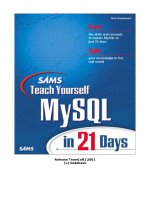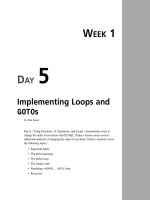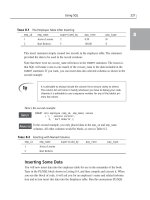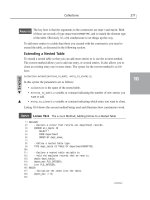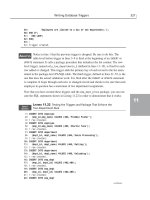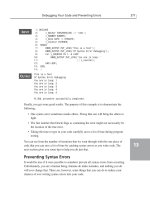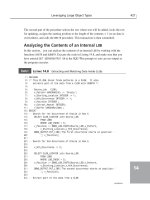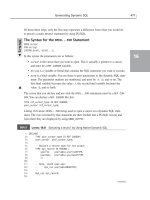Tài liệu Teach Yourself PL/SQL in 21 Days- P14 ppt
Bạn đang xem bản rút gọn của tài liệu. Xem và tải ngay bản đầy đủ của tài liệu tại đây (2.05 MB, 50 trang )
Answers 627
2. What function do I use to combine two strings together?
You use the
CONCAT function; however, you can still rely on || to concatenate
strings.
3. What function converts
‘11/28/99’ to an Oracle DATE?
The
TO_DATE function gives you this flexibility.
4. You can use the
TRUNC and ROUND functions with what data types?
Both
NUMBER and DATE include the ROUND and TRUNC functions.
Exercises
1. Create a PL/SQL block that reads in the month of a date and displays the month in
a Roman numeral format. Use a date of 06/11/67. This allows you to practice the
TO_CHAR function. When printing the Roman numeral equivalent, use LTRIM to
remove any spaces padded to the left of the Roman numeral. If you are really
ambitious, on your own you can create the same RM-type function by using
IF THEN ELSE statements for practice from Day 4. Remember, practice helps
to solidify your knowledge through repetition and understanding.
Here is one solution:
DECLARE
v_Hold_Month Number;
BEGIN
v_Hold_Month := TO_NUMBER(TO_CHAR(TO_DATE(‘11-JUN-67’),’MM’));
DBMS_OUTPUT.PUT_LINE(v_Hold_Month);
DBMS_OUTPUT.PUT_LINE(‘Converted to Roman Numeral ‘ ||
LTRIM(TO_CHAR(v_Hold_Month,’RM’),’ ‘));
END;
/
Your output is
6
Converted to Roman Numeral VI
2. Use the TRUNC function on the SYSDATE to round to the nearest century.
The answer is
SELECT TO_CHAR(TRUNC(SYSDATE,’CC’),’MM/DD/YYYY HH:MI:SS AM’)
“Today’s Date and Time”
from DUAL
The output is similar to
Today’s Date and Time
01/01/1900 12:00:00 AM
A
29 7982 App 11.8.00 11:24 AM Page 627
Please purchase PDF Split-Merge on www.verypdf.com to remove this watermark.
3. Use CONCAT to link two strings together. Repeat the same line by using || instead
of CONCAT.
Here is one solution:
DECLARE
v_String1 VARCHAR2(60) := CONCAT(‘Connect String1 to’,
‘ String2’);
v_String2 VARCHAR2(60) := ‘Connect String1 to’ || ‘ String2’;
BEGIN
DBMS_OUTPUT.PUT_LINE(v_String1);
DBMS_OUTPUT.PUT_LINE(v_String2);
END;
/
Your output looks similar to
Connect String1 to String2
Connect String1 to String2
4. Calculate the number of days between 01/01/97 to 03/31/97. Remember to use the
TRUNC function to eliminate the TIME dependency.
The answer is
SELECT TRUNC(TO_DATE(‘03/31/97’,’MM/DD/YY’)) -
TRUNC(TO_DATE(‘01/01/97’,’MM/DD/YY’)) “Days_Subtracted”
from DUAL;
Your output is
Days_Subtracted
89
5. Convert the CHARACTER string ‘06/11/67’ to a date, and subtract from 06/11/97 to
see how old your author is (and holding).
The answer is
SELECT (TO_DATE(‘06/11/97’,’MM/DD/YY’) -
TO_DATE(‘06/11/67’,’MM/DD/YY’))/365 “Years Old”
from DUAL;
Your output is
Years Old
30.021918
6. Calculate how many months are between 05/15/97 and 08/22/97.
The answer is
628 Appendix
29 7982 App 11.8.00 11:24 AM Page 628
Please purchase PDF Split-Merge on www.verypdf.com to remove this watermark.
Answers 629
SELECT MONTHS_BETWEEN(‘22-AUG-97’,’15-MAY-97’) “Fractional”
from DUAL;
Your output is
Fractional
3.2258065
7. Round the SYSDATE to the nearest century.
The answer is
SELECT TO_CHAR(ROUND(SYSDATE,’CC’),’MM/DD/YYYY HH:MI:SS AM’)
“Today’s Date and Time”
from DUAL;
Your output is similar to
Today’s Date and Time
01/01/2000 12:00:00 AM
8. Calculate the time in Newfoundland from Central Standard Time from 02-22-97,
05:00 AM.
Here is one solution:
SELECT TO_CHAR(NEW_TIME(TO_DATE(‘02-22-97 05:00:00 AM’,
‘MM-DD-YY HH:MI:SS AM’),
‘CST’,’NST’), ‘DD-MON-YY HH:MI:SS AM’)
“Central to Newfoundland”
from DUAL;
Your output is
Central to Newfoundland
22-FEB-97 07:30:00 AM
9. From Listing 6.22, subtract one month and explain the answer.
Two possible answers are
SELECT ADD_MONTHS(TO_DATE(‘31-MAR-97’),-1) from DUAL;
SELECT ADD_MONTHS(TO_DATE(‘31-MAR-97’),-1.5) from DUAL;
The output, of course, is the end of February because February has fewer than 30
days:
ADD_MONTH
28-FEB-97
A
29 7982 App 11.8.00 11:24 AM Page 629
Please purchase PDF Split-Merge on www.verypdf.com to remove this watermark.
10. Calculate the number of days until Christmas from the last day of the month of
today’s date. (We don’t get paid until the end of the month!)
Here is one solution:
SELECT LAST_DAY(SYSDATE) “Last_Day”,
TO_DATE(‘25-DEC-97’) - LAST_DAY(SYSDATE) “Shopping Days”
from DUAL;
The output is similar to
Last_Day Shopping Days
30-JUN-97 177.67266
Day 7, “Procedures, Packages, Errors, and
Exceptions”
Quiz
1. What statement do you use to recompile a procedure?
You use the
CREATE OR REPLACE PROCEDURE command to recompile a procedure.
2. How do you invoke a procedure?
You use the
execute command if you want to explicitly and manually call a proce-
dure. From within a package or another PL/SQL construct, you simply list the pro-
cedure name in the code, and the call to it is made automatically.
3. Name at least four predefined Oracle exception errors.
There are many Oracle predefined exceptions, including
no_data_found,
too_many_rows, invalid_cursor, value_error, invalid_number, zero_divide,
cursor_already_open, and login_denied.
4. How do you call a module of a package?
To call a specific procedure within a package, you use dot notation, as shown in
the following example:
package_name.procedure_name
Exercises
1. Write a package specification for the functions written in previous lessons.
Additionally, include in the specification one or two of the procedures used in this
lesson.
630 Appendix
29 7982 App 11.8.00 11:24 AM Page 630
Please purchase PDF Split-Merge on www.verypdf.com to remove this watermark.
Answers 631
Package specifications contain public declarations of the name of the package and
its functions and procedures. The following is an example and might differ slightly
from your answer:
CREATE PACKAGE day_8_package_spec as
➥package
name declaration
FUNCTION inv_count (qty number, part_nbr varchar2(25)) function
declaration return number;
PROCEDURE pay_salary (emp_id number);
➥procedure
declaration
PROCEDURE hire_employee (emp_name, pay_date number, pay_type char));
➥procedure
declaration
END day_8_package_spec;
2. Write an exception-handling piece of code to trap the error of receiving more rows
than you expected as well as an unknown error.
One possible way to write this exception handler is
exception
WHEN too_many_rows THEN
code to be executed when a SELECT returns
too many rows
END;
WHEN others THEN
code to be executed when an exception is
encountered which is not the too_many_rows
Day 8, “Using SQL to Manipulate Data and
Control Transactions”
Quiz
1. Name some of the database objects that you can base a variable declaration on.
PL/SQL variables can be based on database table columns, other variables, con-
stants, and cursors.
2. Name at least two of the exception types discussed in this chapter.
There are many exceptions that a programmer can prepare for while coding. Some
of the most common are
no_data_found, too_many_rows, invalid_cursor, and
when_others.
A
29 7982 App 11.8.00 11:24 AM Page 631
Please purchase PDF Split-Merge on www.verypdf.com to remove this watermark.
3. Do you need to list the table column names while inserting data into that table?
No. If you elect to omit the column names during an insert statement, Oracle will
automatically align the input data with the columns of the data. The first piece of
data is inserted into the first column, the second piece of data will be inserted into
the second column, and so on.
4. What are the four SQL DML statements permitted in a PL/SQL block?
The four DML statements that are supported within a PL/SQL block are
INSERT,
DELETE, UPDATE, and SELECT.
Exercises
Evaluate each of the following three declarations and determine which ones are legal or
not legal. Explain your answer for those that are not legal.
1. Legal or not legal:
DECLARE
emp_rec emp_rec_type;
This is an invalid declaration because emp_rec_type must be declared prior to this
declaration. A proper declaration would be
DECLARE
TYPE emp_rec_type IS record
(id INTEGER,
name VARCHAR2(35));
emp_rec emp_rec_type;
2. Legal or not legal:
DECLARE
emp_last_name %type;
This is an invalid declaration. The proper declaration would have to include a table
and column reference such as
emp_last_name emp.l_name%type;
3. Legal or not legal:
DECLARE
TYPE emp_table_type is table of VARCHAR2(55);
emp_dept_table emp_table_type;
This declaration is incorrect because the INDEX BY clause is missing. This declara-
tion should look like
DECLARE
TYPE emp_table_type is table of VARCHAR2(55)
INDEX BY BINARY_INTEGER;
emp_dept_table emp_table_type;
632 Appendix
29 7982 App 11.8.00 11:24 AM Page 632
Please purchase PDF Split-Merge on www.verypdf.com to remove this watermark.
Answers 633
Day 9, “Manipulating Data with Cursors”
Quiz
1. What are the cursor attributes and what is their purpose?
The implicit and explicit cursors each have four attributes, which provide useful
information about the cursor. These attributes are
%isopen, %found, %notfound, and
%rowcount.
2. How many cursors can you use at a time?
There are no predefined limits on the number of cursors a session can have. The
only constraint that limits the number of cursors is the availability of memory to
manage them.
3. Where is the cursor pointer when the cursor is first opened?
The cursor pointer is pointing to immediately prior to the first row when the cursor
is first opened.
4. Name the different cursor variable parameter modes and their purpose.
The cursor variable argument can have one of three different modes:
IN—The program can have read-only abilities with the parameter. In other words,
the cursor argument is passed only to the procedure or function.
OUT—The program can return values to the calling PL/SQL block.
IN OUT—The program can read and write to the variable.
Exercise
Create a PL/SQL block that determines the top five highest paid employees from
your Employee table. Be sure to incorporate the usage of the appropriate cursor
attributes. Print these five employees to the screen.
This exercise can be solved in several different ways. Your solution can include
exception handling as well as other methods of processing the data. I have chosen
the following method as my solution:
DECLARE
c_emp_name VARCHAR2(32);
c_sal NUMBER(9,2);
CURSOR emp_cursor is cursor declaration
SELECT emp_name, pay_type
from employee
ORDER BY pay_rate desc; key to getting top 5 highest paid employees
A
29 7982 App 11.8.00 11:24 AM Page 633
Please purchase PDF Split-Merge on www.verypdf.com to remove this watermark.
BEGIN
OPEN emp_cursor;
FETCH emp_cursor
INTO c_emp_name, c_sal; fetch into variables for later use
WHILE emp_cursor%rowcount<=5 and only fetch top 5 employees
emp_cursor%found be sure there is data
LOOP
DBMS_OUTPUT (c_emp_name || ‘ is paid ‘ || c_sal );
prints results to screen
FETCH emp_cursor INTO c_emp_name, c_sal;
END LOOP;
CLOSE emp_cursor; closes the cursor
END;
Day 10, “Collections”
Quiz
1. Name the three collection types PL/SQL supports.
The three collection types PL/SQL supports are index-by tables, nested tables, and
varrays.
2. What declaration would you use to declare a variable named
emp_name with a
datatype and size that exactly match the definition of the employee.emp_name col-
umn in the database?
In this case, the declaration would be
emp_name employee.emp_name%type.
3. What declaration would you use to declare a record named
emp that matches the
definition of a row in the employee table?
To declare
emp to match the employee table, use emp employee%rowtype.
4. What method can you call on to be sure that a collection element really exists?
The
exists method can be used to determine whether a given element exists.
5. What must you be sure to do before you can add data to a nested table or to a
varray?
Before you can do anything with a nested table or a varray, you must initialize it
with the value returned by its constructor function.
634 Appendix
29 7982 App 11.8.00 11:24 AM Page 634
Please purchase PDF Split-Merge on www.verypdf.com to remove this watermark.
Answers 635
Exercise
Write the code necessary to generate a PL/SQL nested table with 10 new depart-
ment IDs and names. Use department ID numbers that are not currently being used
in the database. Make up the department names. Next, write a FORALL statement
that inserts all the records by using a bulk bind.
Here is one possible solution to the exercise:
1: DECLARE
2: Define a nested table type for department IDs and names.
3: TYPE dept_id IS TABLE OF department.dept_id%TYPE;
4: TYPE dept_name IS TABLE OF department.dept_name%TYPE;
5:
6: Declare a nested table variable for each type.
7: dept_ids dept_id;
8: dept_names dept_name;
9: inx1 PLS_INTEGER;
10: BEGIN
11: Initialize the collections
12: dept_ids := dept_id();
13: dept_names := dept_name();
14:
15: Extend once, outside the loop for better performance.
16: dept_ids.extend(10);
17: dept_names.extend(10);
18:
19: Generate 10 new departments, numbered from
20: 1101-1110.
21: FOR inx1 IN 1 10 LOOP
22: dept_ids(inx1) := inx1 + 1100;
23: dept_names(inx1) := ‘Dept #’ || TO_CHAR(inx1+1100);
24: END LOOP;
25:
26: FORALL x IN dept_ids.first dept_ids.last
27: INSERT INTO department (dept_id, dept_name)
28: VALUES (dept_ids(x), dept_names(x));
29: END;
30: /
The nested tables types are declared in lines 3–4. The corresponding variables are
declared in lines 7–8. The tables are initialized by calling their constructor meth-
ods in lines 12–13. Because we know that we are going to deal with only 10 elements,
only one call to extend is made for each table. These calls occur in lines 16–17, and they
extend each table by 10 entries. The loop in lines 21–24 generates 10 new departments,
numbered from 1101 through 1110. The FORALL statement in lines 26–28 inserts these
10 rows into the department table.
A
INPUT
ANALYSIS
29 7982 App 11.8.00 11:24 AM Page 635
Please purchase PDF Split-Merge on www.verypdf.com to remove this watermark.
Day 11, “Writing Database Triggers”
Quiz
1. Which data manipulation statements can support triggers?
INSERT, UPDATE, and DELETE.
2. What are the four basic parts of a trigger?
The event that fires the trigger, the database table on which the trigger is defined,
the optional
WHEN clause, and the PL/SQL block containing the code to be
executed.
3. In a trigger, what are the correlation names
:OLD and :NEW used for?
:OLD is used to refer to the values in a row before it is changed. :NEW is used to
refer to the values after the row is changed.
4. What is the name of the system view that can be used to retrieve trigger defini-
tions?
The
USER_TRIGGERS view shows all triggers you own. In addition, you might want
to look at the ALL_TRIGGERS view and the DBA_TRIGGERS view. The ALL_TRIGGERS
view adds triggers that others own but which are defined on your tables. If you
have database administrator privileges, the DBA_TRIGGERS view lists all triggers
defined in the database.
5. What is a mutating table?
A mutating table is one that is in the process of being modified by the SQL state-
ment which fired a trigger. Because the table is being changed it is not in a consis-
tent state and Oracle does not allow queries against it.
6. Name some possible uses for triggers.
Some possible uses for triggers are enforcing a business rule, enforcing security,
logging changes, replicating data, and calculating column values.
Exercises
1. Write a set of triggers to maintain the emp_name and dept_name fields redundantly
in the emp_dept relation so that you do not have to join the employee and depart-
ment tables just to get a simple department listing.
636 Appendix
29 7982 App 11.8.00 11:24 AM Page 636
Please purchase PDF Split-Merge on www.verypdf.com to remove this watermark.
Answers 637
Here is one solution:
CREATE OR REPLACE TRIGGER emp_dept_names
BEFORE INSERT OR UPDATE OF emp_id, dept_id ON emp_dept
FOR EACH ROW
DECLARE
redundant_dept_name department.dept_name%TYPE;
redundant_emp_name employee.emp_name%TYPE;
BEGIN
Get the employee’s name
BEGIN
SELECT emp_name INTO redundant_emp_name
FROM employee
WHERE employee.emp_id = :NEW.emp_id;
EXCEPTION
the employee record may not exist.
WHEN OTHERS THEN
redundant_emp_name := ‘’;
END;
Get the department name
BEGIN
SELECT dept_name INTO redundant_dept_name
FROM department
WHERE department.dept_id = :NEW.dept_id;
EXCEPTION
the department record may not exist.
WHEN OTHERS THEN
redundant_dept_name := ‘’;
END;
Store the employee and department names in the emp_dept record.
:NEW.dept_name := redundant_dept_name;
:NEW.emp_name := redundant_emp_name;
END;
/
Trigger created.
CREATE OR REPLACE TRIGGER department_emp_dept
AFTER UPDATE OF dept_name ON department
FOR EACH ROW
BEGIN
UPDATE emp_dept
SET emp_dept.dept_name = :NEW.dept_name
WHERE emp_dept.dept_id = :NEW.dept_id;
END;
A
INPUT/
OUTPUT
29 7982 App 11.8.00 11:24 AM Page 637
Please purchase PDF Split-Merge on www.verypdf.com to remove this watermark.
/
Trigger created.
CREATE OR REPLACE TRIGGER employee_emp_dept
AFTER UPDATE OF emp_name ON employee
FOR EACH ROW
BEGIN
UPDATE emp_dept
SET emp_dept.emp_name = :NEW.emp_name
WHERE emp_dept.emp_id = :NEW.emp_id;
END;
/
Trigger created.
The first trigger, emp_dept_name, handles inserts and updates on the emp_dept
table itself. Whenever a new record is inserted or an existing record updated, the
current employee and department names are retrieved from their respective tables and
stored with the emp_dept record. The second trigger, department_emp_dept, ensures that
any changes to a department’s name are propagated to all the related records in the
emp_dept table. The third trigger does the same thing for changes to employee names.
Writing these triggers almost leads to a mutation problem. Recall the
emp_dept_upd trig-
ger shown in Listing 11.3. It is defined to fire only when the dept_id field is updated. In
other words, it is defined as AFTER UPDATE OF dept_id ON emp_dept. Removing the
words OF dept_id would cause it to fire whenever an emp_dept record was changed. In
that case, a change to a department name would fire department_emp_dept, which
would issue an update against the emp_dept table. That would in turn fire the
emp_dept_upd trigger, which would issue an update against the department table, which
in turn would mutate because the SQL statement that started all this was an update
against that table.
2. Write the SQL statements necessary to populate the
emp_name and dept_name
fields for any existing emp_dept records.
This could be done as either one or two updates. Here is a solution done with one
UPDATE statement:
UPDATE emp_dept ed
SET emp_name = (SELECT emp_name
FROM employee e
WHERE e.emp_id = ed.emp_id),
dept_name = (SELECT dept_name
FROM department d
WHERE d.dept_id = ed.dept_id);
638 Appendix
ANALYSIS
29 7982 App 11.8.00 11:24 AM Page 638
Please purchase PDF Split-Merge on www.verypdf.com to remove this watermark.
Answers 639
Day 12, “Using Oracle8i Objects for Object-
Oriented Programming”
Quiz
1. What is the difference between a class and an object?
A class, or an object type, as it is called by Oracle, serves as the blueprint for one
or more objects. It is just a design, and you might compare it to a table definition.
An object, on the other hand, represents an instance of a class. You can create
many objects of a given type, just as you can create many records in a table.
2. What are the allowed return values for an
ORDER function?
The allowed return values for an
ORDER function are 0, 1, and -1. A 0 value means
that the two objects being compared are equal. A value of -1 means that the object
whose method was called is less than the other object. A value of 1 means that the
object whose method was called is greater than the other object.
3. An object table has one column for each attribute of an object, plus one additional
column. What is this additional column used for?
The extra column in an object table is used to store the object identifier, which
uniquely identifies that object in the database. It is an Oracle-generated value, and
is automatically assigned to each object when it is first stored in the table.
4. How is an object reference different from an object?
An object reference functions similarly to a pointer in a language such as C. It is
used to store a reference from one object to another. It is only a pointer, and in
order to access the referenced object, you must use that pointer in a query to
retrieve the specified object.
5. How many attributes must an object have? How many methods?
An object must have at least one attribute. It does not, however, have to have any
methods.
6. What datatypes are allowed for the return value of a
MAP function?
A
MAP function can return values only of type NUMBER, VARCHAR2,or DATE.
7. What are accessor and mutator methods?
Accessor methods are member functions that exist primarily to enable you to
retrieve specific attribute values from an object. Mutator methods are member pro-
cedures that enable you to set the value of a specific attribute or set of attributes.
Using accessor and mutator methods helps insulate your code from changes to an
object’s underlying implementation.
A
29 7982 App 11.8.00 11:24 AM Page 639
Please purchase PDF Split-Merge on www.verypdf.com to remove this watermark.
Exercises
1. Write a stored function that creates and returns an object of type building. This
function should accept as parameters the building’s name, its address, and the man-
ager’s employee number. Have the function check the database before creating the
new building object, to be sure that another building with the same name does not
already exist. If another building with the same name does exist, the function
should return null.
Here is one solution:
1: CREATE OR REPLACE FUNCTION CreateBuilding (
2: This is an example of how you can work around the
3: fact that you can’t write your own “constructor” for
4: the building object. This stored function serves
5: as a psuedo-constructor. Note however, that Oracle can’t
6: force you to call this.
7: inBldgName VARCHAR2,
8: inBldgStreet VARCHAR2,
9: inBldgCity VARCHAR2,
10: inBldgStateAbbr VARCHAR2,
11: inBldgZip VARCHAR2,
12: inBldgMgr employee.emp_id%TYPE
13: ) RETURN building AS
14: TheNewBldg building;
15: NoFlag integer;
16: BEGIN
17: Check to see if this building already exists.
18: SELECT count(*) INTO NoFlag
19: FROM buildings
20: WHERE BldgName = inBldgName;
21:
22: IF NoFlag > 0 THEN
23: RETURN null;
24: END IF;
25:
26: Check to see if the manager employee id is valid.
27: SELECT count(*) INTO NoFlag
28: FROM employee
29: WHERE emp_id = inBldgMgr;
30:
31: IF NoFlag = 0 THEN
32: RETURN null;
33: END IF;
34:
35: All validation checks have been passed, create the new
36: building object.
37: TheNewBldg := building (inBldgName
38: ,address (inBldgStreet
39: ,’’ no second addr line
640 Appendix
INPUT
29 7982 App 11.8.00 11:24 AM Page 640
Please purchase PDF Split-Merge on www.verypdf.com to remove this watermark.
Answers 641
40: ,inBldgCity
41: ,inBldgStateAbbr
42: ,inBldgZip
43: ,’’) no phone number
44: ,inBldgMgr);
45:
46: RETURN TheNewBldg;
47: END;
48: /
Function created.
49: Create some building objects
50: DECLARE
51: a_building building;
52: BEGIN
53: This will succeed
54: a_building := CreateBuilding(‘The Red Barn’,
55: ‘101 Pasture Lane’,
56: ‘Mio’,’MI’,’48826’,599);
57: dbms_output.put_line(‘Created: ‘ || a_building.BldgName);
58:
59: This will fail because the building exists.
60: a_building := CreateBuilding(‘East Storage Shed’,
61: ‘101 Pasture Lane’,
62: ‘Mio’,’MI’,’48826’,599);
63: dbms_output.put_line(‘Created: ‘ ||
64: nvl(a_building.BldgName,’Nothing’));
65:
66: This will fail because the manager does not exist.
67: a_building := CreateBuilding(‘The Blue Barn’,
68: ‘101 Pasture Lane’,
69: ‘Mio’,’MI’,’48826’,999);
70: dbms_output.put_line(‘Created: ‘ ||
71: nvl(a_building.BldgName,’Nothing’));
72:
73: END;
74: /
Created: The Red Barn
Created: Nothing
Created: Nothing
PL/SQL procedure successfully completed.
The CreateBuilding function takes five arguments: a building name, street
address, city, state abbreviation, and manager ID. It returns an object of type
building. The SELECT statement in lines 18–20 first checks to see if a building with the
same name already exists. Then the SELECT statement in lines 27–29 checks to be sure
A
ANALYSIS
29 7982 App 11.8.00 11:24 AM Page 641
Please purchase PDF Split-Merge on www.verypdf.com to remove this watermark.
that the manager ID is a valid employee ID. If everything checks out, the building
constructor is called in lines 37–44 to actually create the building object, which is
then returned to the calling program (see line 46).
The PL/SQL block at the end of the listing (lines 50–74) shows the results of three
attempts to create
building objects. The first succeeds. The second fails because a build-
ing with the same name already exists. The third also fails, but this time because the
building manager ID does not represent a valid employee ID.
2. Modify the
building object type definition to use a MAP function, instead of an
ORDER function, for comparisons.
Here is one solution:
1: CREATE OR REPLACE TYPE building AS OBJECT (
2: BldgName VARCHAR2(40),
3: BldgAddress address,
4: BldgMgr INTEGER,
5: MEMBER PROCEDURE ChangeMgr (NewMgr IN INTEGER),
6: MAP MEMBER FUNCTION Compare
7: RETURN VARCHAR2
8: );
9:
10: Type created.
11:
12: CREATE OR REPLACE TYPE BODY building AS
13: MEMBER PROCEDURE ChangeMgr(NewMgr IN INTEGER) IS
14: BEGIN
15: BldgMgr := NewMgr;
16: END;
17:
18: MAP MEMBER FUNCTION Compare
19: RETURN VARCHAR2 IS
20: BEGIN
21: RETURN BldgName;
22: END;
23: END;
24: /
Type body created.
This version of the building object is much the same as the one you first created
from Listing 12.7, except that it has a MAP function defined instead of an ORDER
function. This MAP function, declared in lines 6–7 and defined in lines 18–22 of the sec-
ond segment, simply returns the building name. When comparing objects of type
building,Oracle will call this function and base the comparison on the values returned.
642 Appendix
INPUT
ANALYSIS
29 7982 App 11.8.00 11:24 AM Page 642
Please purchase PDF Split-Merge on www.verypdf.com to remove this watermark.
Answers 643
Day 13, “Debugging Your Code and
Preventing Errors”
Quiz
1. True or False: Logic errors are easier to debug than syntax errors.
False. Because the compiler doesn’t point them out, logic errors are almost always
more difficult to debug than syntax errors.
2. Missing a semicolon is what type of an error?
A syntax error.
3. Provide the answer to the calculation 6 + 4 / 2 = ?.
The expression
6 + 4 / 2 evaluates to 8. The division takes precedence over the
addition, so it is done first.
4. True or False: Commenting code is a waste of time.
False. Comments improve the readability of code and clarify the intent of the
application programmer.
5. True or False: Formatting code is not necessary.
False. If you don’t format your code, it will be difficult to read, increasing the like-
lihood of making a mistake.
Exercise
The DEBUG package in this lesson always writes debugging messages to the file
named debug.txt. That will cause problems if multiple developers use the package
at once. Modify the DEBUG package as follows:
• Modify the
ERASE procedure to accept a filename. This filename will be used
by subsequent calls to the OUT procedure.
• Modify both the
OUT and ERASE procedures so that if no filename is passed,
or if ERASE is never called, no file is created and no messages get written.
For extra credit, add an
ASSERT procedure to the DEBUG package, and build in a flag
so that you can enable and disable assertions at will.
In one possible solution to the exercise, the modified
DEBUG package would look
like this:
A
29 7982 App 11.8.00 11:24 AM Page 643
Please purchase PDF Split-Merge on www.verypdf.com to remove this watermark.
1: CREATE OR REPLACE PACKAGE DEBUG AS
2: /* Procedure OUT is used to output a comment of your
3: choice, along with the contents of the variable. The
4: Procedure OUT statement defines the function.*/
5: PROCEDURE OUT(p_Comments IN VARCHAR2,
6: p_Variable IN VARCHAR2);
7:
8: /* Procedure Erase begins a new file.
9: Used to start a new debugging process. Good idea to call
10: this function first. */
11: PROCEDURE Erase (p_filename IN VARCHAR2);
12:
13: /*Procedure ASSERT tests a condition, and raises an error
14: if that condition is not true. */
15: PROCEDURE assert (
16: p_condition IN BOOLEAN,
17: p_message IN VARCHAR2);
18: END DEBUG; End Definition of package DEBUG
19: /
20:
21: CREATE OR REPLACE PACKAGE BODY DEBUG AS
22: log_filename VARCHAR2(30) := ‘’;
23:
24: PROCEDURE OUT(p_Comments IN VARCHAR2,
25: p_Variable IN VARCHAR2) IS
26: v_MyFHOUT UTL_FILE.FILE_TYPE; Declare File Handle
27:
28: BEGIN
29: /* Exit if no filename has been specified. */
30: IF log_filename = ‘’ THEN
31: RETURN;
32: END IF;
33:
34: /* Use A to append all output being sent to the file */
35: v_MyFHOUT := UTL_FILE.FOPEN(‘c:\a’,log_filename,’a’);
36:
37: /* This outputs the Time and Date as MM-DD-YY HH:MM:SS
38: followed by comments, and then by the contents of the
39: variables. Each element is surrounded by quotation marks,
40: and separated by a comma.*/
41:
42: UTL_FILE.PUT_LINE(v_MyFHOUT,’”’||
43: TO_CHAR(SYSDATE,’mm-dd-yy HH:MM:SS AM’)
44: || ‘“,”Comment: ‘ || p_Comments ||
45: ‘“,”Variable Contents: ‘ || p_Variable || ‘“‘);
46:
47: /* Close the file handle which points to debug.txt */
48: UTL_FILE.FCLOSE(v_MyFHOUT);
49: EXCEPTION
50: /* Create Exception to display error code and message */
51: WHEN OTHERS THEN
644 Appendix
INPUT
29 7982 App 11.8.00 11:24 AM Page 644
Please purchase PDF Split-Merge on www.verypdf.com to remove this watermark.
Answers 645
52: DBMS_OUTPUT.PUT_LINE
53: (‘ERROR ‘ || to_char(SQLCODE) || SQLERRM);
54: NULL; Do Nothing
55: END OUT; End Execution of Procedure OUT
56:
57:
58: PROCEDURE Erase (p_filename IN VARCHAR2) IS
59: v_MyFH UTL_FILE.FILE_TYPE; Create File Handle
60: BEGIN
61: /* Save the filename, then check to see if it is blank.
62: If the filename is blank, then do not do anything more. */
63: log_filename := p_filename;
64: IF log_filename = ‘’ THEN
65: RETURN;
66: END IF;
67:
68: /* Open file to overwrite current file contents.
69: This erases the original file.*/
70:
71: v_MyFH := UTL_FILE.FOPEN(‘c:\a’,log_filename,’w’);
72:
73: Close the file handle which points to debug.txt
74: UTL_FILE.FCLOSE(v_MyFH);
75:
76: EXCEPTION
77: Create Exception to display error code and message
78: WHEN OTHERS THEN
79: DBMS_OUTPUT.PUT_LINE
80: (‘ERROR ‘ || to_char(SQLCODE) || SQLERRM);
81: NULL;
82: END Erase; End Procedure Erase
83:
84: PROCEDURE ASSERT (
85: p_condition IN BOOLEAN,
86: p_message IN VARCHAR2) AS
87: BEGIN
88: IF NOT p_condition THEN
89: RAISE_APPLICATION_ERROR (-20000,p_message);
90: END IF;
91: END ASSERT;
92:
93: BEGIN
94: Erase(‘debug.txt’); Erase contents of the file
95: END DEBUG; End procedure DEBUG
96: /
As you can see, the ASSERT procedure has been added to this package. The proce-
dure header is in lines 15–17, and the procedure body is in lines 84–91. Further,
the ERASE procedure has been modified to accept a filename as an argument (lines
11 and 58). If the filename is blank, the ERASE procedure stores it and quits (lines
A
29 7982 App 11.8.00 11:24 AM Page 645
Please purchase PDF Split-Merge on www.verypdf.com to remove this watermark.
63–66). The OUT procedure has also been modified. The first thing it does, in lines
29–31, is check the filename. If the filename is blank, OUT returns without logging
any debugging information. So not only can you now write debugging information
to any file you like, but you can also turn the feature off.
Day 14, “Leveraging Large Object Types”
Quiz
1. What are the two types of internal LOBs?
The two types of internal
LOBs are the persistent and the temporary LOBs.
2. What is the maximum size of a
LOB?
4GB.
3. Can you write to external files?
Currently, you can only read from external files, not write to them.
4. When copying
LOBs from one row to another, is a new locator copied?
Not only is a new locator created, but the entire
LOB from the row is copied. If you
have some 4GB objects, this table can eat up storage space fast!
Exercise
Create a temporary LOB that is of BLOB datatype, that will not be stored in the
buffer, and that will be limited to the current call.
Your solution should look similar to this:
begin
DBMS_LOB.CREATETEMPORARY
( blob_lob_loc,
FALSE,
DBMS_LOB.CALL);
End;
In this solution, you have created a temporary LOB of the BLOB datatype. You
have specified that it will not be stored in memory and will disappear after the
current Oracle8i call.
Day 15, “Managing Transactions and Locks”
Quiz
1. How is a transaction ended?
A transaction is ended when it is committed or rolled back.
646 Appendix
INPUT
ANALYSIS
29 7982 App 11.8.00 11:24 AM Page 646
Please purchase PDF Split-Merge on www.verypdf.com to remove this watermark.
Answers 647
2. What is the difference between row locking and table locking?
Row locks are enabled when a specific row is being modified by a DML statement.
Table locks are acquired either explicitly or implicitly when either a row or a table
is being modified.
3. What is the purpose of a savepoint?
Savepoints are like bookmarks within a transaction: They facilitate the rollback of
a transaction to some intermediate point, which is defined by the placement of the
savepoint.
4. What is the purpose of the two-phase commit?
Oracle’s two-phase commit mechanism guarantees that all database servers partici-
pating in a distributed transaction either all commit or all roll back the statements
in the transaction.
5. What is the typical return value for when the
DBMS_LOCK function ran successfully?
The typical returned value from the
DBMS_LOCK function will be 0 when it ran suc-
cessfully.
Exercise
Write a PL/SQL block that establishes a savepoint, inserts a single record into the
employee table, commits the data if the new record does not replicate an existing
record, or rolls back the data if the new record insert fails.
Here is one solution:
SAVEPOINT exercise; use this to roll back to
INSERT INTO employee VALUES (10, ‘Loraine Williams’,2,4000.00,’S’);
COMMIT; saves the data if insert was successful
this is not executed if there is an exception
EXCEPTION
WHEN DUP_VAL_ON_INDEX THEN exception handler
ROLLBACK; back out data from insert
Day 16, “Generating Dynamic SQL”
Quiz
1. For DML and DDL statements, and also for queries, what punctuation must not be
included at the end of the query?
You must not end queries, DDL statements, or DML statements with a semicolon.
A
INPUT
29 7982 App 11.8.00 11:24 AM Page 647
Please purchase PDF Split-Merge on www.verypdf.com to remove this watermark.
2. What is meant by the term dynamic SQL?
A dynamic SQL statement is one that a program generates when it is running. It is
dynamic because it can change from one run to the next. A static SQL statement,
on the other hand, is written directly into your program code, and never changes.
3. What is Oracle’s term for the new version of dynamic SQL?
Oracle uses the term native dynamic SQL to describe the new dynamic SQL fea-
tures released with Oracle8i.
4. When using native dynamic SQL, what new form of the
OPEN statement is used to
open a cursor on a dynamic SQL statement?
The
OPEN FOR statement is used to open a cursor on a dynamic SQL statement.
Exercise
Write a stored procedure to take a username as an argument, and create a version
of mytable in that user’s schema.
The following is one possible solution to this problem:
1: CREATE OR REPLACE PROCEDURE make_mytable (
2: username IN VARCHAR2
3: ) AS
4: create_stmt VARCHAR2(200);
5: BEGIN
6: Build up the CREATE TABLE statement.
7: create_stmt := ‘CREATE TABLE ‘
8: || username || ‘.mytable’
9: || ‘(myrow NUMBER, mydesc VARCHAR2(50))’;
10:
11: Execute the statement just built.
12: EXECUTE IMMEDIATE create_stmt;
13: END;
14: /
The variable create_stmt, declared in line 4, will ultimately contain the CREATE
TABLE statement that this procedure builds. Lines 7–9 build that statement, and the
username parameter is referenced in line 8 to specify that user’s schema as the scheme in
which the table is to be created. Line 12 contains the EXECUTE IMMEDIATE statement that
executes the SQL statement in the create_stmt variable, thus creating the table.
648 Appendix
INPUT
ANALYSIS
29 7982 App 11.8.00 11:24 AM Page 648
Please purchase PDF Split-Merge on www.verypdf.com to remove this watermark.
Answers 649
Day 17, “Writing to Files and the Display”
Quiz
1. What is the difference between PUT and PUT_LINE?
PUT_LINE adds a newline after the text that you write, and PUT does not.
2. Assuming that you use the version of
FOPEN where no line size is specified, what is
the maximum number of bytes that can be read by using GET_LINE?
The default maximum line size is 1,023 bytes.
3. What is the maximum line size that you can specify with the
FOPEN call?
The maximum line size you can specify in an
FOPEN call is 32,767 bytes.
4. What does
FCLOSE_ALL do to the file open flag referenced by IS_OPEN?
Nothing. If you close files by using
FCLOSE_ALL,the IS_OPEN function still reports
them as being open.
5. What is the maximum number of characters that can possibly be allocated to the
buffer when using
DBMS_OUTPUT?
One million. The buffer size can range from 2,000 to 1,000,000.
Exercise
Listing 17.5 shows how to write comma-delimited data to a file. Using GET_LINE
instead of PUT_LINE, modify that code to read the data back and display it by using
DBMS_OUTPUT.
The following is one possible solution to the exercise:
SQL> SET SERVEROUTPUT ON
SQL>
SQL> DECLARE
2 emp_data UTL_FILE.FILE_TYPE;
3 end_of_file_flag BOOLEAN;
4 emp_data_line VARCHAR2(80);
5 BEGIN
6 Open the file
7 emp_data := UTL_FILE.FOPEN (‘c:\a’,’empdata.csv’,’R’);
8
9 Read all the data from the file
10 end_of_file_flag := FALSE;
11 LOOP
12 BEGIN
A
INPUT
29 7982 App 11.8.00 11:24 AM Page 649
Please purchase PDF Split-Merge on www.verypdf.com to remove this watermark.
13 UTL_FILE.GET_LINE(emp_data, emp_data_line);
14 EXCEPTION
15 WHEN NO_DATA_FOUND THEN
16 end_of_file_flag := TRUE;
17 WHEN OTHERS THEN
18 raise;
19 END;
20
21 IF NOT end_of_file_flag THEN
22 Display the line for SQL*Plus users to see.
23 DBMS_OUTPUT.PUT_LINE (emp_data_line);
24 ELSE
25 EXIT;
26 END IF;
27 END LOOP;
28
29 Close the file
30 UTL_FILE.FCLOSE (emp_data);
31
32 EXCEPTION
33 WHEN UTL_FILE.internal_error THEN
34 DBMS_OUTPUT.PUT_LINE
35 (‘UTL_FILE: An internal error occurred.’);
36 UTL_FILE.FCLOSE_ALL;
37 WHEN UTL_FILE.invalid_filehandle THEN
38 DBMS_OUTPUT.PUT_LINE
39 (‘UTL_FILE: The file handle was invalid.’);
40 UTL_FILE.FCLOSE_ALL;
41 WHEN UTL_FILE.invalid_mode THEN
42 DBMS_OUTPUT.PUT_LINE
43 (‘UTL_FILE: An invalid open mode was given.’);
44 UTL_FILE.FCLOSE_ALL;
45 WHEN UTL_FILE.invalid_operation THEN
46 DBMS_OUTPUT.PUT_LINE
47 (‘UTL_FILE: An invalid operation was attempted.’);
48 UTL_FILE.FCLOSE_ALL;
49 WHEN UTL_FILE.invalid_path THEN
50 DBMS_OUTPUT.PUT_LINE
51 (‘UTL_FILE: An invalid path was give for the file.’);
52 UTL_FILE.FCLOSE_ALL;
53 WHEN UTL_FILE.read_error THEN
54 DBMS_OUTPUT.PUT_LINE
55 (‘UTL_FILE: A read error occurred.’);
56 UTL_FILE.FCLOSE_ALL;
57 WHEN UTL_FILE.write_error THEN
58 DBMS_OUTPUT.PUT_LINE
59 (‘UTL_FILE: A write error occurred.’);
60 UTL_FILE.FCLOSE_ALL;
61 WHEN others THEN
62 DBMS_OUTPUT.PUT_LINE (‘Some other error occurred.’);
63 UTL_FILE.FCLOSE_ALL;
64 END;
65 /
650 Appendix
29 7982 App 11.8.00 11:24 AM Page 650
Please purchase PDF Split-Merge on www.verypdf.com to remove this watermark.
Answers 651
502,”Kim Beanie”
511,”Jeffrey Beaner”
512,”junk”
513,”Herman D. Terman”
514,”Egan Dryup”
401,”Harvey Wallbanger”
501,”Ashley Nue”
402,”Scarlet Tanninger”
403,”Freddie Fisher”
404,”Charlie Tuna”
597,”Matthew Higgenbottom”
598,”Raymond Gennick”
PL/SQL procedure successfully completed.
Lines 11–27 contain the read loop. Here, each line is read from the file and dis-
played by using DBMS_OUTPUT. The actual read is embedded within a nested
PL/SQL block (lines 12–19) because of the need to detect the end-of-file. Encountering
an end-of-file will result in a NO_DATA_FOUND exception being raised. This is trapped
in lines 15–16, where the end-of-file flag is set to TRUE. When the flag becomes true,
the loop exits.
Day 18, “Managing Database Jobs”
Quiz
1. If the server goes down for two days (Monday to Tuesday), and a job with an exe-
cution of SYSDATE + 7 was supposed to run when the server went down (Tuesday),
will the job always run on the original day of the week (that is, run every
Tuesday)?
No, because the new
SYSDATE is assigned when the server is restored (Wednesday),
the job will now be running every Wednesday until the job is altered or removed,
or another problem occurs.
2. Why must you use two single quotes around parameters specified in
SUBMIT, when
you used to need only one set of single quotes?
When Oracle parses the data and removes the quotes, any part that does not have
two sets of single quotes and is a string parameter is stripped down to no single
quotes and thus causes the job to fail.
3. Can you alter someone else’s job?
Only if you know the owner’s login and password and sign on as that person. In
other words…no!
A
ANALYSIS
OUTPUT
29 7982 App 11.8.00 11:24 AM Page 651
Please purchase PDF Split-Merge on www.verypdf.com to remove this watermark.

